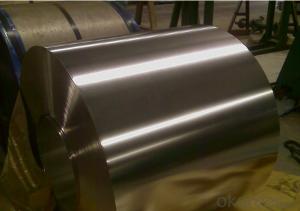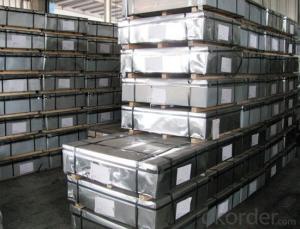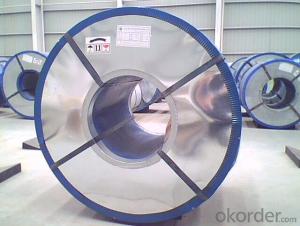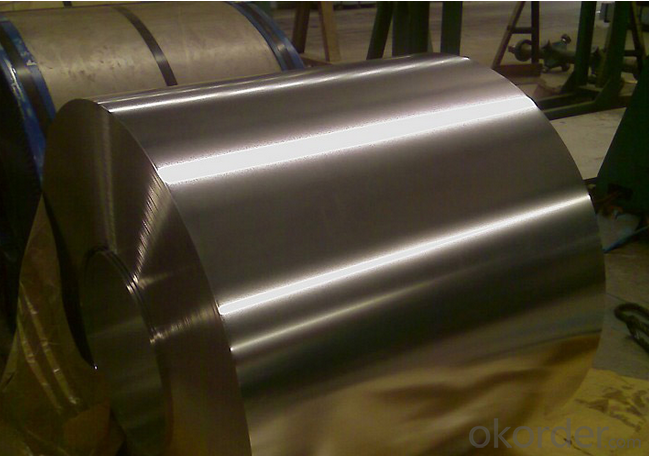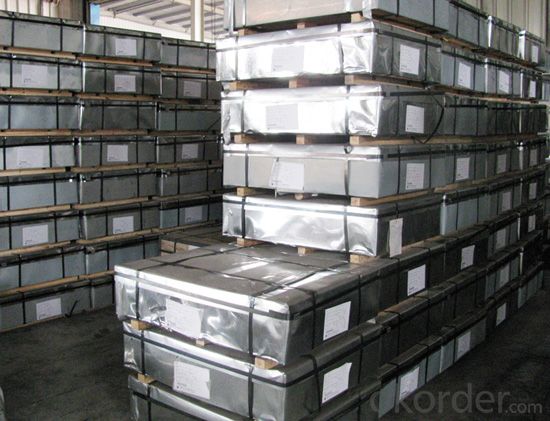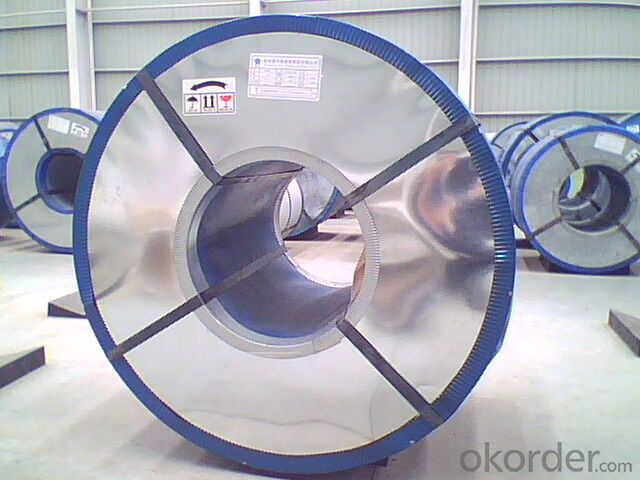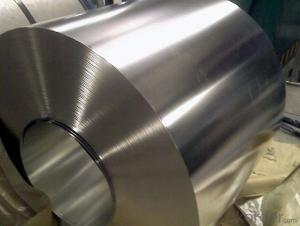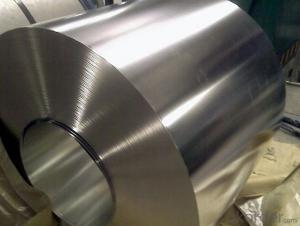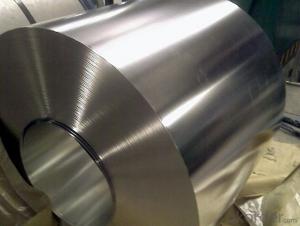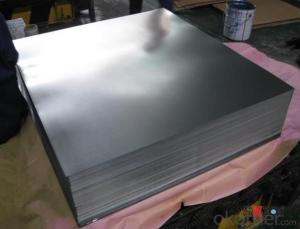Electrolytic Tinplate (ETP) Coil and Sheets for Foods and Chemical Packaging
- Loading Port:
- Tianjin
- Payment Terms:
- TT OR LC
- Min Order Qty:
- 25 m.t.
- Supply Capability:
- 7000 m.t./month
OKorder Service Pledge
OKorder Financial Service
You Might Also Like
1.Structure of Electrolytic Tinplate (ETP) Coil and Sheets for Foods and Chemical Packaging Description
Electrolytic Tin Plate Coils and Sheets for Foods Metal Packaging, is one thin steel sheet with a coating of tin applied by electrolytic deposition. Tinplate made by this process is essentially a sandwich in which the central core is strip steel. This core is cleaned in a pickling solution and then fed through tanks containing electrolyte, where tin is deposited on both sides. As the strip passes between high-frequency electric induction coils, it is heated so that the tin coating melts and flows to form a lustrous coat.
2.Main Features of the Electrolytic Tinplate (ETP) Coil and Sheets for Foods and Chemical Packaging
Appearance – Electrolytic Tin Plate is characterized by its beautiful metallic luster. Products with various kinds of surface roughness are produced by selecting the surface finish of the substrate steel sheet.
Paintability and printability – Electrolytic Tin Plates have excellent paintability and printability. Printing is beautifully finished using various lacquers and inks.
Formability and strength – Electrolytic Tin Plates have got very good formability and strength. By selecting a proper temper grade, appropriate formability is obtained for different applications as well as the required strength after forming.
Corrosion resistance – Tinplate has got good corrosion resistance. By selecting a proper coating weight, appropriate corrosion resistance is obtained against container contents. Coated items should meet 24 hour 5 % salt spray requirement.
Solderability and weldability – Electrolytic Tin Plates can be joined both by soldering or welding. These properties of tinplate are used for making various types of cans.
Hygienic – Tin coating provides good and non toxic barrier properties to protect food products from impurities, bacteria, moisture, light and odours.
Safe – Tinplate being low weight and high strength makes food cans easy to ship and transport.
Eco friendly – Tinplate offers 100 % recyclability.
Tin is not good for low temperature applications since it changes structure and loses adhesion when exposed to temperatures below – 40 deg C.
3.Electrolytic Tinplate (ETP) Coil and Sheets for Foods and Chemical Packaging Images
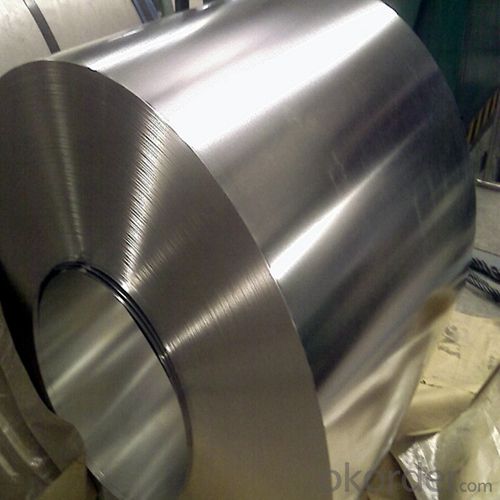

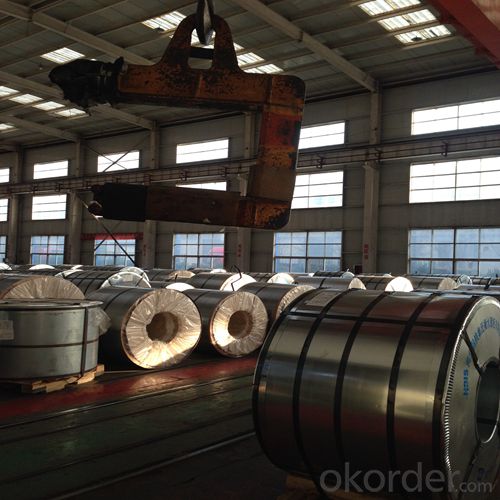
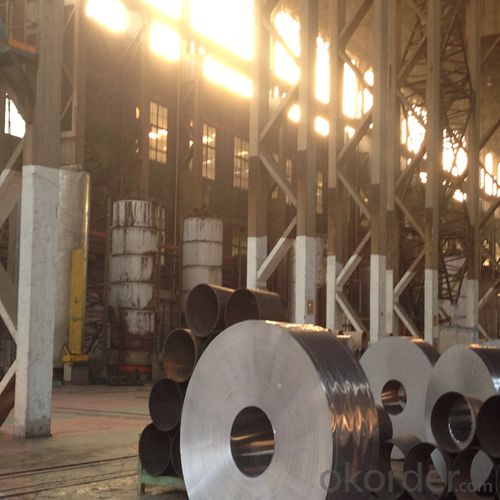
4.Electrolytic Tinplate (ETP) Coil and Sheets for Foods and Chemical Packaging Specification
Standard | ISO 11949 -1995, GB/T2520-2000,JIS G3303,ASTM A623, BS EN 10202
|
Material | MR,SPCC |
Thickness | 0.15mm - 0.50mm |
Width | 600mm -1150mm |
Temper | T1-T5 |
Annealing | BA & CA |
Coil Inner Diameter | 508mm |
Weight | 6-10 tons/coil 1~1.7 tons/sheets bundle |
Passivation | 311 |
Oil | DOS |
Surface | Finish,bright,stone,matte,silver |
5.FAQ of Electrolytic Tinplate (ETP) Coil and Sheets for Foods and Chemical Packaging
- How are the Electrolytic Tin Plates specified?
The Electrolytic Tin Plates are specified as per the steel base, extent of tempering, the coating weight, annealing method and the surface finish.
- How many types there are for base steels?
The base steels are of three types: Type MR, L, D
- How many types there are for base steels?
The base steels are of three types: Type MR, L, D
- Q: How does tinplate contribute to the resistance of marine equipment?
- Tinplate contributes to the resistance of marine equipment by providing a protective coating that prevents corrosion and rusting. The tin layer acts as a barrier, shielding the underlying metal from the corrosive effects of saltwater and other environmental factors, thereby increasing the longevity and durability of the equipment in marine environments.
- Q: What are the main growth opportunities for the tinplate industry?
- The main growth opportunities for the tinplate industry include the increasing demand for packaged food and beverages, the rising popularity of sustainable packaging solutions, and the growing automotive sector requiring tinplate for various applications. Additionally, emerging markets and technological advancements in tinplate production processes offer significant growth potential for the industry.
- Q: Can tinplate be used for packaging baby food and formula?
- Yes, tinplate can be used for packaging baby food and formula. Tinplate is a type of steel coated with a thin layer of tin, which provides a protective barrier against moisture, odors, and contaminants. It is considered a safe and suitable material for packaging sensitive products like baby food and formula, as it helps to preserve the quality and freshness of the contents while ensuring the safety and health of infants.
- Q: Can tinplate be used for solar panel applications?
- Yes, tinplate can be used for solar panel applications. Tinplate is often used as a protective coating for solar panels due to its corrosion resistance and ability to reflect sunlight. It acts as a barrier against moisture and environmental elements, ensuring the durability and longevity of the solar panels. Additionally, tinplate can enhance the overall efficiency of solar panels by reducing heat absorption and improving energy conversion.
- Q: How can tinplate be identified?
- If the food is ready to eat food grade, dressed in non food is to chemical grade on it.
- Q: How is tinplate affected by different types of beverages?
- Tinplate is generally resistant to most types of beverages, including acidic ones. However, certain highly acidic or corrosive beverages, such as fruit juices, can cause a chemical reaction with the tin coating, potentially leading to a metallic taste or discoloration. To prevent this, tinplate cans are often lined with a protective coating, such as lacquer or polymer, to ensure the beverage's quality and safety.
- Q: Can tinplate be welded?
- Yes, tinplate can be welded using specialized welding techniques such as spot welding or resistance welding.
- Q: How is tinplate coated for signage?
- Tinplate for signage is typically coated through a process called electroplating, where a thin layer of tin is deposited onto the surface of the metal. This coating provides protection against corrosion and enhances the aesthetic appeal of the signage.
- Q: Can tinplate be used for packaging of non-food products?
- Yes, tinplate can be used for packaging of non-food products. Tinplate is a versatile material that offers several advantages such as durability, corrosion resistance, and recyclability, making it suitable for packaging various non-food items such as cosmetics, electronics, chemicals, and more.
- Q: How does tinplate affect the overall branding of products?
- Tinplate can have a significant impact on the overall branding of products. Its sleek and shiny appearance can enhance the visual appeal, making the product more attractive to consumers. Additionally, tinplate offers a durable and protective packaging solution, ensuring the product remains in optimal condition. This can help build trust and credibility among consumers, positively influencing the brand image. Furthermore, tinplate can be easily customized through printing and embossing techniques, allowing brands to incorporate their logos, slogans, and other branding elements, thereby strengthening brand recognition and recall.
Send your message to us
Electrolytic Tinplate (ETP) Coil and Sheets for Foods and Chemical Packaging
- Loading Port:
- Tianjin
- Payment Terms:
- TT OR LC
- Min Order Qty:
- 25 m.t.
- Supply Capability:
- 7000 m.t./month
OKorder Service Pledge
OKorder Financial Service
Similar products
Hot products
Hot Searches
Related keywords
